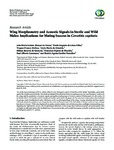Use este identificador para citar ou linkar para este item:
http://www.alice.cnptia.embrapa.br/alice/handle/doc/1036278Registro completo de metadados
| Campo DC | Valor | Idioma |
|---|---|---|
| dc.contributor.author | SOUZA, J. M. G. A. de S. | pt_BR |
| dc.contributor.author | LIMA-FILHO, P. A. de | pt_BR |
| dc.contributor.author | MOLINA, W. F. | pt_BR |
| dc.contributor.author | ALMEIDA, L. M. de | pt_BR |
| dc.contributor.author | GOUVEIA, M. B. de | pt_BR |
| dc.contributor.author | MACÊDO, F. P. de | pt_BR |
| dc.contributor.author | LAUMANN, R. A. | pt_BR |
| dc.contributor.author | PARANHOS, B. A. J. | pt_BR |
| dc.date.accessioned | 2016-02-05T11:11:11Z | pt_BR |
| dc.date.available | 2016-02-05T11:11:11Z | pt_BR |
| dc.date.created | 2016-02-05 | pt_BR |
| dc.date.issued | 2015 | pt_BR |
| dc.identifier.citation | The Scientific World Journal, 2015. | pt_BR |
| dc.identifier.uri | http://www.alice.cnptia.embrapa.br/alice/handle/doc/1036278 | pt_BR |
| dc.description | The sterile insect technique (SIT) is widely utilized in the biological control of fruit flies of the family Tephritidae, particularly against theMediterranean fruit fly.This study investigated the interaction between mating success and morphometric variation in the wings and the production of acoustic signals among three male groups of Ceratitis capitata (Wiedemann): (1) wild males, (2) irradiated with Co-60 (steriles), and (3) irradiated (steriles) and treated with ginger oil.Thecanonical variate analysis discriminated two groups (males irradiated andmales wild), based on themorphological shape of the wings. Amongmales that emit buzz signals, wild males obtained copulation more frequently than males in Groups 2 and 3.The individuals of Group 3 achieved more matings than those inGroup 2.Wild males displayed lower pulse duration, higher intervals between pulses, and higher dominant frequency. Regarding the reproductive success, the morphological differences in the wings? shape between accepted and nonaccepted males are higher in wildmales than in the irradiated ones. The present results can be useful in programs using the sterile insect technique for biological control of C. capitata. | pt_BR |
| dc.language.iso | eng | eng |
| dc.rights | openAccess | eng |
| dc.subject | Inseto estéril | pt_BR |
| dc.subject | Mosta-das-frutas | pt_BR |
| dc.subject | Sterile insect | pt_BR |
| dc.title | Wing morphometry and acoustic signals in sterile and wild males: implications for mating success in Ceratitis capitata. | pt_BR |
| dc.type | Artigo de periódico | pt_BR |
| dc.date.updated | 2016-03-28T11:11:11Z | pt_BR |
| dc.subject.thesagro | Controle biológico | pt_BR |
| dc.subject.thesagro | Inseto | pt_BR |
| dc.subject.thesagro | Praga | pt_BR |
| dc.subject.thesagro | Acasalamento | pt_BR |
| dc.subject.thesagro | Ceratitis Capitata | pt_BR |
| dc.subject.nalthesaurus | Biological control | pt_BR |
| dc.subject.nalthesaurus | Fruit flies | pt_BR |
| dc.subject.nalthesaurus | sterile insect technique | pt_BR |
| dc.description.notes | Article ID 526969. | pt_BR |
| riaa.ainfo.id | 1036278 | pt_BR |
| riaa.ainfo.lastupdate | 2016-03-28 | pt_BR |
| dc.identifier.doi | 10.1155/2015/526969 | pt_BR |
| dc.contributor.institution | JOÃO MARIA GOMES ALENCAR DE SOUZA, UFRN; PAULO AUGUSTO DE LIMA-FILHO, INSTITUTO FEDERAL DO RIO GRANDE DO NORTE; WAGNER FRANCO MOLINA, UFRN; LÚCIA MARIA DE ALMEIDA, UFRN; MILSON BEZERRA DE GOUVEIA, UFRN; FRANCISCO PEPINO DE MACÊDO, UFRN; RAUL ALBERTO LAUMANN, CENARGEN; BEATRIZ AGUIAR GIORDANO PARANHOS, CPATSA. | pt_BR |
| Aparece nas coleções: | Artigo em periódico indexado (CPATSA)  | |
Arquivos associados a este item:
| Arquivo | Descrição | Tamanho | Formato | |
|---|---|---|---|---|
| Beatriz42015.pdf | 1,72 MB | Adobe PDF |  Visualizar/Abrir |









